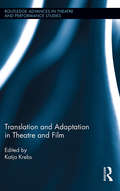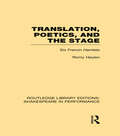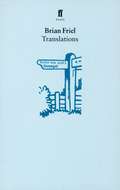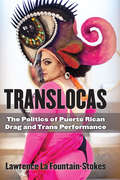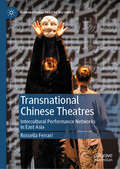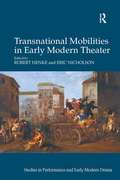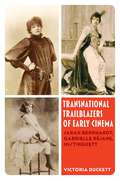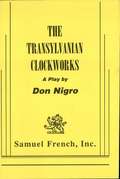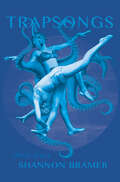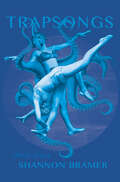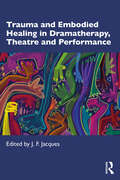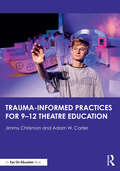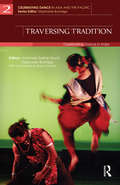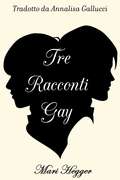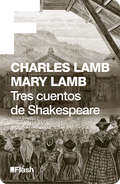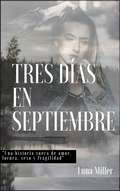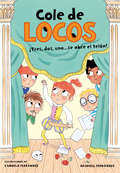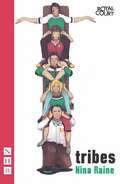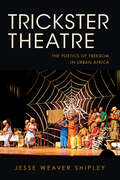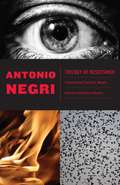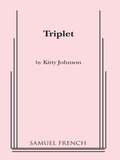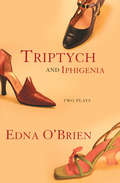- Table View
- List View
Translation and Adaptation in Theatre and Film (Routledge Advances in Theatre & Performance Studies)
by Katja KrebsThis book provides a pioneering and provocative exploration of the rich synergies between adaptation studies and translation studies and is the first genuine attempt to discuss the rather loose usage of the concepts of translation and adaptation in terms of theatre and film. At the heart of this collection is the proposition that translation studies and adaptation studies have much to offer each other in practical and theoretical terms and can no longer exist independently from one another. As a result, it generates productive ideas within the contact zone between these two fields of study, both through new theoretical paradigms and detailed case studies. Such closely intertwined areas as translation and adaptation need to encounter each other’s methodologies and perspectives in order to develop ever more rigorous approaches to the study of adaptation and translation phenomena, challenging current assumptions and prejudices in terms of both. The book includes contributions as diverse yet interrelated as Bakhtin’s notion of translation and adaptation, Bollywood adaptations of Shakespeare’s Othello, and an analysis of performance practice, itself arguably an adaptive practice, which uses a variety of languages from English and Greek to British and International Sign-Language. As translation and adaptation practices are an integral part of global cultural and political activities and agendas, it is ever more important to study such occurrences of rewriting and reshaping. By exploring and investigating interdisciplinary and cross-cultural perspectives and approaches, this volume investigates the impact such occurrences of rewriting have on the constructions and experiences of cultures while at the same time developing a rigorous methodological framework which will form the basis of future scholarship on performance and film, translation and adaptation.
Translation, Poetics, and the Stage: Six French Hamlets (Routledge Library Editions: Shakespeare in Performance)
by Romy HeylenThis book establishes an analytical model for the description of existing translations in their historical context within a framework suggested by systemic concepts of literature. It argues against mainstream 20th-century translation theory and, by proposing a socio-cultural model of translation, takes into account how a translation functions in the receiving culture. The case studies of successive translations of "Hamlet" in France from the eighteenth century neoclassical version of Jean-Francois Ducis to the 20th-century Lacanian, post-structuralist stage production of Daniel Mesguich show the translator at work. Each chapter focuses on a different aspect of the changing theatrical and literary norms to which translators through the ages have been bound by the expectations both of their audiences and the literary establishment.
Translations
by Brian FrielThe action takes place in late August 1833 at a hedge-school in the townland of Baile Beag, an Irish-speaking community in County Donegal. In a nearby field camps a recently arrived detachment of the Royal Engineers, making the first Ordnance Survey. For the purposes of cartography, the local Gaelic place names have to be recorded and rendered into English. In examining the effects of this operation on the lives of a small group, Brian Friel skillfully reveals the far-reaching personal and cultural effects of an action which is at first sight purely administrative.
Translocas: The Politics of Puerto Rican Drag and Trans Performance (Triangulations: Lesbian/Gay/Queer Theater/Drama/Performance)
by Lawrence La Fountain-StokesTranslocas focuses on drag and transgender performance and activism in Puerto Rico and its diaspora. Arguing for its political potential, Lawrence La Fountain-Stokes explores the social and cultural disruptions caused by Latin American and Latinx “locas” (effeminate men, drag queens, transgender performers, and unruly women) and the various forms of violence to which queer individuals in Puerto Rico and the U.S. are subjected. This interdisciplinary, auto-ethnographic, queer-of-color performance studies book explores the lives and work of contemporary performers and activists including Sylvia Rivera, Nina Flowers, Freddie Mercado, Javier Cardona, Jorge Merced, Erika Lopez, Holly Woodlawn, Monica Beverly Hillz, Lady Catiria, and Barbra Herr; television programs such as RuPaul’s Drag Race; films such as Paris Is Burning, The Salt Mines, and Mala Mala; and literary works by authors such as Mayra Santos-Febres and Manuel Ramos Otero. Lawrence La Fountain-Stokes, a drag performer himself, demonstrates how each destabilizes (and sometimes reifies) dominant notions of gender and sexuality through drag and their embodied transgender expression. These performances provide a means to explore and critique issues of race, class, poverty, national identity, and migratory displacement while they posit a relationship between audiences and performers that has a ritual-like, communal dimension. The book also analyzes the murders of Jorge Steven López Mercado and Kevin Fret in Puerto Rico, and invites readers to challenge, question, and expand their knowledge about queer life, drag, trans performance, and Puerto Rican identity in the Caribbean and the diaspora. The author also pays careful attention to transgender experience, highlighting how trans activists and performers mold their bodies, promote social change, and create community in a context that oscillates between glamour and abjection.
Transmedia Knowledge for Liberal Arts and Community Engagement: A StudioLab Manifesto (Digital Education and Learning)
by Jon McKenzieThis book sets forth a pedagogy for renewing the liberal arts by combining critical thinking, media activism, and design thinking. Using the StudioLab approach, the author seeks to democratize the social and technical practices of digital culture just as nineteenth century education sought to democratize literacy. This production of transmedia knowledge—from texts and videos to comics and installations—moves students between seminar, studio, lab, and field activities. The book also wrestles with the figure of Plato and the very medium of knowledge to re-envision higher education in contemporary societies, issuing a call for community engagement as a form of collective thought-action.
Transnational Chinese Theatres: Intercultural Performance Networks in East Asia (Transnational Theatre Histories)
by Rossella FerrariThis is the first systematic study of networks of performance collaboration in the contemporary Chinese-speaking world and of their interactions with the artistic communities of the wider East Asian region. It investigates the aesthetics and politics of collaboration to propose a new transnational model for the analysis of Sinophone theatre cultures and to foreground the mobility and relationality of intercultural performance in East Asia. The research draws on extensive fieldwork, interviews with practitioners, and direct observation of performances, rehearsals, and festivals in Asia and Europe. It offers provocative close readings and discourse analysis of an extensive corpus of hitherto untapped sources, including unreleased video materials and unpublished scripts, production notes, and archival documentation.
Transnational Mobilities in Early Modern Theater (Studies in Performance and Early Modern Drama)
by Robert Henke Eric NicholsonThe essays in this volume investigate English, Italian, Spanish, German, Czech, and Bengali early modern theater, placing Shakespeare and his contemporaries in the theatrical contexts of western and central Europe, as well as the Indian sub-continent. Contributors explore the mobility of theatrical units, genres, performance practices, visual images, and dramatic texts across geo-linguistic borders in early modern Europe. Combining 'distant' and 'close' reading, a systemic and structural approach identifies common theatrical units, or 'theatergrams' as departure points for specifying the particular translations of theatrical cultures across national boundaries. The essays engage both 'dramatic' approaches (e.g., genre, plot, action, and the dramatic text) and 'theatrical' perspectives (e.g., costume, the body and gender of the actor). Following recent work in 'mobility studies,' mobility is examined from both material and symbolic angles, revealing both ample transnational movement and periodic resistance to border-crossing. Four final essays attend to the practical and theoretical dimensions of theatrical translation and adaptation, and contribute to the book’s overall inquiry into the ways in which values, properties, and identities are lost, transformed, or gained in movement across geo-linguistic borders.
Transnational Trailblazers of Early Cinema: Sarah Bernhardt, Gabrielle Réjane, Mistinguett (Cinema Cultures in Contact #5)
by Prof. Victoria Harriet DuckettA free ebook version of this title is available through Luminos, University of California Press’s Open Access publishing program. Visit www.luminosoa.org to learn more. At the forefront of the entertainment industries of the late nineteenth and early twentieth centuries were singular actors: Sarah Bernhardt, Gabrielle Réjane, and Mistinguett. Talented and formidable women with global ambitions, these performers forged connections with audiences across the world while pioneering the use of film and theatrics to gain international renown. Transnational Trailblazers of Early Cinema traces how these women emerged from the Parisian periphery to become world-famous stars. Building upon extensive archival research in France, England, and the United States, Victoria Duckett argues that, through intrepid business prowess and the use of early multimedia to cultivate their celebrity image, these three artists strengthened ties between countries, continents, and cultures during pivotal years of change.
Transylvanian Clockworks
by Don NigroMystery / 4m, 3f / Unit set / The author of Ravenscroft investigates the Dracula myth in a powerful, complex, darkly funny and utterly terrifying vampire play unlike any you have ever experienced. Set in London and Transylvania in 1888 the year of Jack the Ripper, it captures the erotic power and poetry of Stoker's novel while looking more deeply into the characters' souls to examine the sensual and frightening undercurrents of this captivating Victorian tale. Jonathan Harker has returned from Transylvania so profoundly disturbed that he is confined to Dr. Seward's mental hospital and Van Helsing has been called in to help unravel the mystery of Jonathan's dementia. Jonathan's version of events at Castle Dracula leads them into a horrifying nightmare involving the mysterious foreign gentleman who seems to be seducing the women in Jonathan's life. A complex labyrinth of fear, desire, violence and lurking evil spirals into a horrific and surprising conclusion. The Transylvania Clockworks is an elegant, original, subtle, poetic and exhilarating piece of Gothic theatre.
Trapsongs: Three Plays
by Shannon Bramer Sara TilleyWith an introduction by Sara TilleyFrom playwright and poet Shannon Bramer comes Trapsongs, a collection of three dark comedies that navigate the realm of the surreal and absurd.In "Monarita," an intimate friendship between Mona, a frazzled new mother, and Rita, her beloved, estranged friend, is explored. Their interaction is a dance—part ballet, part mud-fight. In "The Collectors," Hanna Parson is being harassed by three ghastly collection agents who force her to confront her debt and isolation as she struggles to create meaningful art in her dishevelled apartment. And in the tragicomedy "The Hungriest Woman in the World," Aimee, a former artist, invites her preoccupied, workaholic husband, Robert, to the theatre to see a play about a sad octopus. His refusal sends her on a dark and playful journey into the topsy-turvy world of theatre itself.Trapsongs is by turns comedic, grotesque, and profane, but is all the while a tender exploration of the human condition in all its hilarious and humbling glory. Although each of these plays is a discrete creation, they contain and hold each other like a Matryoshka doll; all of the main characters are trapped within the song of their own lives.
Trapsongs: Three Plays
by Shannon BramerWith an introduction by Sara TilleyFrom playwright and poet Shannon Bramer comes Trapsongs, a collection of three dark comedies that navigate the realm of the surreal and absurd. In "Monarita," an intimate friendship between Mona, a frazzled new mother, and Rita, her beloved, estranged friend, is explored. Their interaction is a dance—part ballet, part mud-fight. In "The Collectors," Hanna Parson is being harassed by three ghastly collection agents who force her to confront her debt and isolation as she struggles to create meaningful art in her dishevelled apartment. And in the tragicomedy "The Hungriest Woman in the World," Aimee, a former artist, invites her preoccupied, workaholic husband, Robert, to the theatre to see a play about a sad octopus. His refusal sends her on a dark and playful journey into the topsy-turvy world of theatre itself.Trapsongs is by turns comedic, grotesque, and profane, but is all the while a tender exploration of the human condition in all its hilarious and humbling glory. Although each of these plays is a discrete creation, they contain and hold each other like a Matryoshka doll; all of the main characters are trapped within the song of their own lives.
Trapsongs: Three Plays
by Shannon BramerWith an introduction by Sara TilleyFrom playwright and poet Shannon Bramer comes Trapsongs, a collection of three dark comedies that navigate the realm of the surreal and absurd.In "Monarita," an intimate friendship between Mona, a frazzled new mother, and Rita, her beloved, estranged friend, is explored. Their interaction is a dance—part ballet, part mud-fight. In "The Collectors," Hanna Parson is being harassed by three ghastly collection agents who force her to confront her debt and isolation as she struggles to create meaningful art in her dishevelled apartment. And in the tragicomedy "The Hungriest Woman in the World," Aimee, a former artist, invites her preoccupied, workaholic husband, Robert, to the theatre to see a play about a sad octopus. His refusal sends her on a dark and playful journey into the topsy-turvy world of theatre itself.Trapsongs is by turns comedic, grotesque, and profane, but is all the while a tender exploration of the human condition in all its hilarious and humbling glory. Although each of these plays is a discrete creation, they contain and hold each other like a Matryoshka doll; all of the main characters are trapped within the song of their own lives.
Trauma and Embodied Healing in Dramatherapy, Theatre and Performance
by J. F. JacquesThis edited volume explores the singularity of embodiment and somatic approaches in the healing of trauma from a dramatherapy, theatre and performance perspective.Collating voices from across the fields of dramatherapy, theatre and performance, this book examines how different interdisciplinary and intercultural approaches offer unique and unexplored perspectives on the body as a medium for the exploration, expression and resolution of chronic, acute and complex trauma as well as collective and intergenerational trauma. The diverse chapters highlight how the intersection between dramatherapy and body-based approaches in theatre and performance offers additional opportunities to explore and understand the creative, expressive and imaginative capacity of the body, and its application to the healing of trauma.The book will be of particular interest to dramatherapists and other creative and expressive arts therapists. It will also appeal to counsellors, psychotherapists, psychologists and theatre scholars.
Trauma–Informed Practices for 9-12 Theatre Education
by Jimmy Chrismon Adam W. CarterThis resource bridges the worlds of education, mental health, and the performing arts to offer a comprehensive roadmap for 9–12 theatre educators looking to promote safe, supportive, and creative spaces for their students. Written by a seasoned theatre educator and a licensed mental health clinician, this book explores trauma-informed teaching techniques tailored specifically for theatre classrooms, encompassing both acting and production processes. Chapters cover a broad range of topics, from fostering resilience in students to collaborating with caregivers, administrators, and communities across the educational journey. The authors introduce essential concepts such as intimacy direction and consent, ensuring ethical and inclusive practices. They also provide strategies for teachers to prioritize their own self-care. Core themes and objectives include: trauma-informed teaching, holistic theatre production, community engagement, ethical theatre practices, and educator wellness. Packed with practical exercises for exploration, discussion questions for book studies, and meticulously researched insights, this resource strikes a balance between therapeutic guidance and professional development. Ideal for 9–12 theatre educators in drama classrooms, after-school programs, and more, this guide equips you with the tools to support students who may have experienced trauma, empowering them in performing arts environments while maintaining healthy boundaries.
Traversing Tradition: Celebrating Dance in India (Celebrating Dance in Asia and the Pacific)
by Stephanie Burridge Urmimala Sarkar MunsiDance occupies a prestigious place in Indian performing arts, yet it curiously, to a large extent, has remained outside the arena of academic discourse. This book documents and celebrates the emergence of contemporary dance practice in India. Incorporating a multidisciplinary approach, it includes contributions from scholars, writers and commentators as well as short essays and interviews with Indian artists and performers; the latter add personal perspectives and insights to the broad themes discussed. Young Indian dance artists are courageously charting out new trajectories in dance, diverging from the time-worn paths of tradition. The classical forms of Bharatnatyam, Kathak, Odissi and Manipuri, to name a few, are rich resources for choreographers exploring contemporary dance. This volume speaks about their struggles of working within and outside tradition as they grapple with national and international audience expectations as well as their own values and sense of identity. The artists represented here continue to question the uneasy relationship that exists between the insular world of dance and outside reality. Simultaneously, they are actively creating new dance languages that are both articulate in a performative context and demand examination by researchers and critics.
Tre racconti gay
by Mari Hegger Annalisa GallucciTre racconti di tre ragazzi che non si conoscono ma hanno molto amore nei loro cuori. Il primo ragazzo, Alessandro, porta dentro il peso e il dolore di essere innamorato di un suo amico di scuola, Fábio, ma i loro destini saranno travolti dalle lacrime. Nel secondo racconto, l'autore tratta di una storia d'amore tra due ragazzi che durò tre mesi, ma che sembrava sarebbe durata per tutta la vita. In questo racconto, il personaggio principale imparerà una lezione: non innamorarti di qualcuno che ti amerà sino ad incontrare una persona migliore. Nell'ultimo racconto, si parlerà di un matrimonio. Un ragazzo molto coraggioso, e innamorato, farà un grande passo avanti e una domanda pericolosa al suo innamorato.
Tres cuentos de Shakespeare
by Charles Y LambLos Cuentos de Shakespeare, escritos por los hermanos Charles y Mary Lamb a principios del siglo XIX, en pleno auge del romanticismo, son un clásico de la literatura inglesa, adaptaciones brillantes y autónomas que han contribuido a difundir y a realzar la modernidad imperecedera de William Shakespeare. Sirvan como muestra los tres que aquí ofrecemos: «Macbeth», «Romeo y Julieta» y «Hamlet, Príncipe de Dinamarca».
Tres cuentos gays
by Mari Hegger Mauricio SantosEl libro tiene tres historias que involucran tres chicos que no conocen, pero que comparten el deseo de amar. El primero es un niño llamado Alessandro, quien tiene la carga y el dolor de haber caído en el amor con su colega Fabio escuela, giros implican su destino de lágrimas. En la segunda historia, el autor cuenta la historia de tres meses de salir con dos hijos, su amor parecía ser algo para toda la vida. En este libro el personaje principal va a aprender una gran lección: no hacer cita con alguien que te ame incluso encontrar algo mejor. Finalmente una historia que implica el matrimonio, donde un niño muy valiente y apasionada hará una pregunta grande y peligroso para su amada.
Tres días en Septiembre
by Luna Miller Daniel Martín del Campo M/O¿Has sentido alguna vez un anhelo desesperado por algo o por alguien? Quizás no siempre sabemos lo que deseamos, a pesar de que la sensación sea ensordecedoramente fuerte, así es como siente Gabriel, y como el artista joven, muy atractivo y demasiado inquieto que es, ignora ese sentimiento y se va a una aldea desierta en Ludvika para desarrollar una idea de trabajo. Bueno, nada resultará como lo piensa, de repente, él es una de las piezas de un juego donde cada movimiento parece tener consecuencias fatales, consecuencias que se ramifican en una ciudad aparentemente soñolienta. A una velocidad acelerada, Anna, Kessa, Lea, Johan y Niklas pronto enfrentarán su destino, es una novela que trata de la amistad, el amor y la aventura en ciernes, pero también de la manipulación, la infidelidad, la violencia y la muerte. Después de estos tres días en septiembre, no habrá vuelta atrás.
Tres, dos uno... ¡Se abre el telón! (Cole de locos #Volumen 6)
by Dashiell Fernández Pena¡Sexta aventura del cole más loco, una divertida serie de primeras lecturas sobre la escuela, la familia y los amigos! Preparar una obra de teatro no es nada fácil, y menos todavía cuando cada uno hace lo que quiere. Lucas ha modificado el guion incluyendo sus bromas habituales, Asim no consigue recordar su parte y las gemelas no logran actuar de forma creíble. La coordinación es un drama, pero Carlos (con la ayuda de su padre), se encargará de poner orden y conseguir hacer una buenísima actuación. ¡Que empiece la función!
Tribes
by Nina RaineIn Tribes, Billy, who is deaf, is the only one who actually listens in his idiosyncratic, fiercely argumentative bohemian family. But when he meets Sylvia, who is going deaf, he decides he finally wants to be heard. With excoriating dialogue and sharp, compassionate insights, Nina Raine crafts a penetrating play about belonging, family and the limitations of communication. Nominated for both the Olivier and Evening Standard Awards for Best Play, Tribes premiered at the Royal Court Theatre in London in 2011. Under the direction of David Cromer, the comic drama is currently receiving its North American premiere in New York City at Barrow Street Theatre through June 3, 2012.
Trickster Theatre: The Poetics of Freedom in Urban Africa (African Expressive Cultures)
by Jesse Weaver ShipleyTrickster Theatre traces the changing social significance of national theatre in Ghana from its rise as an idealistic state project from the time of independence to its reinvention in recent electronic, market-oriented genres. Jesse Weaver Shipley presents portraits of many key figures in Ghanaian theatre and examines how Akan trickster tales were adapted as the basis of a modern national theatre. This performance style tied Accra's evolving urban identity to rural origins and to Pan-African liberation politics. Contradictions emerge, however, when the ideal Ghanaian citizen is a mythic hustler who stands at the crossroads between personal desires and collective obligations. Shipley examines the interplay between on-stage action and off-stage events to show how trickster theatre shapes an evolving urban world.
Trilogy of Resistance
by Antonio NegriWith Trilogy of Resistance, the political philosopher Antonio Negri extends his intervention in contemporary politics and culture into a new medium: drama. The three plays collected for the first time in this volume dramatize the central concepts of the innovative and influential thought he has articulated in his best-selling books Empire and Multitude, coauthored with Michael Hardt. In the tradition of Bertolt Brecht and Heiner Müller, Negri&’s political dramas are designed to provoke debate around the fundamental questions they raise about resistance, violence, and tyranny. In Swarm, the protagonist searches for an effective mode of activism; with the help of a Greek-style chorus, she tries on different roles, from the suicide bomber and party apparatchik to the multitude. The Bent Man, set in fascist Italy, focuses on a woodcutter who resists fascism by bending himself in two and using his own now-twisted body as a weapon against war. In Cithaeron, perhaps the most audacious of the three plays, Negri reworks Euripides&’s Bacchae to explore the circumstances that would compel a diverse and creative community to withdraw from both the despotic government that constrains it and the traditional family relationships that reinforce that despotism.First published in France in 2009 and featuring an introduction by Negri, Trilogy of Resistance provides a direct and passionate distillation of Negri&’s concepts and offers insights into one of the most important projects in political philosophy currently under way, as well as a timely reminder of the power of theater to effectively dramatize complex and challenging ideas.
Triplet
by Kitty JohnsonComedy \ 3 f. \ Int. \ This insightful look at growing up female takes place on a wedding day. As the bride gets ready for the big event, she converses with herself as a 13-year-old princess and as a 21-year-old virgin. The "three" reveal various truths about themselves, their lives as they thought they would be and as they actually are. This is a wonderful play by a distinct and clever voice.
Triptych and Iphigenia: Two Plays (Books That Changed the World)
by Edna O'BrienTwo plays by the acclaimed Irish author: an adaption of Euripides and an “emotionally bruising drama” of three women obsessed with the same man (The New York Times).TriptychWith searing acuity, O’Brien presents the story of three women—a mistress, a wife, and a daughter—who are all helplessly drawn to Henry: their lover, husband, and father. While Henry himself never appears, his specter is never absent as these women confront the ways that love can simultaneously liberate and entrap. Triptych is a powerful work that explores sex, marriage, and predatory relationships.IphigeniaIn this modern take on the Greek tragedy, O’Brien takes creative license with Euripides’s tale of a daughter sacrificed for the sake of war. This taut, contemporary version presents, in O’Brien’s own words, “a more equal representation of the power and presence of both male and female characters” (Edna O’Brien, Independent, UK).“Intriguingly original . . . emotionally brave and engagingly clever.” –R. Hurwitt, The San Francisco Chronicle
